The main objectives of most platform games are pretty much the same—a player needs to successfully reach the finish point and travel to the next one. But a scenery's setup can differ partly because of technical issues that primarily include calculating the capabilities of old devices. The simplest scenery setup is known as the single-screen setup . As the name implies, a game level fits one screen only and its position is fixed. Thus, the main objective can be reinterpreted as "reach the upper part of the screen and move to the next level." The following is a screenshot of Rayman Jungle Run from Ubisoft:
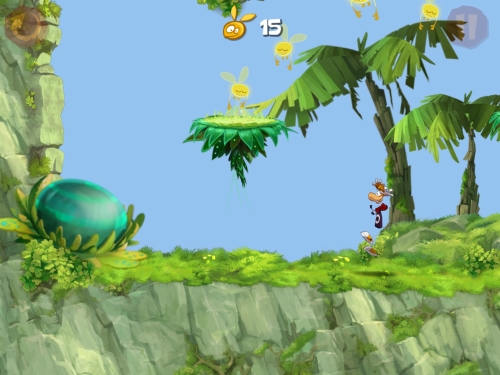
Most of the early games that pioneered the genre used this concept because it did not require a large number of resources. Few examples are Space Panic (1980) by Universal, Rise Out from Dungeons (1983) by ASCII, and Donkey Kong (1981) by Nintendo. Although by present-day standards these games were not perfect and advanced, they introduced and tested some cornerstone elements as platforms—ladders to climb vertically, the ability to jump (this feature appeared in the original Donkey Kong), and many others.
The disadvantages of the single-screen setup are evident: levels' dimensions are fixed; to construct a complex platform structure, you need to reduce the size of the elements dramatically; and characters should be tiny and indistinguishable, making the graphic expressiveness pretty low. Moreover, such games are not perceived as truly dynamic because the level composition is static and small moving parts are not convincing enough. This is good for puzzling but only satisfactory for faster types of gameplay, which is why the setup is not quite popular nowadays. Nevertheless, it is not forgotten that there are many modern games (generally, indie ones) based on this concept. Among them, in my opinion, the real masterpiece is Shaun the Sheep—Home Sheep Home 2 by Chillingo Ltd (http://www.chillingo.com/games/home-sheep-home-2/), which features beautiful artwork and funny gameplay.
The following screenshot shows the puzzle-adventure game Limbo, featuring gloomy beautiful, and very atmospheric settings:

Most game developers choose for their new projects the single screen's successor, scrolling setup . It implies that the levels are larger than one individual screen and the game scrolls through them to show content; figuratively speaking, the game board is a long strip of elements.
The traditional direction of scrolling is horizontal (from right to left), but there are other options: some games ask players to climb up, so the screen moves vertically, other ones utilize both directions. Besides the classic side view of the scenery, a perspective scrolling can be used, which is suitable for games based on 3D engines.
Scrolling platformers usually look faster since the landscape moves constantly, so the player always concentrates on new elements. There are many wonderful scrolling platformers for iOS. For instance, Cordy by SilverTree Media (http://silvertreemedia.com/products/cordy) with a very cute main character and pictorial-level design. Another platform is a gloomy and genius masterpiece, a very unique and creative game Limbo (http://limbogame.org/). Limbo looks like a talented example of art cinema and gives the player a breathtaking gaming experience. Penumbear by Bulkypix (http://www.bulkypix.com/game/penumbear) is a very good example too: exciting story, interesting visuals, and a bunch of wonderfully designed puzzles. Another personal favorite is the visual presentation of Rayman Jungle Run (http://www.ubi.com/US/Games/Info.aspx?pId=11178) by Ubisoft; it is perfectly animated and illustrated. The following screenshot shows a graphic fragment from an endless running platform game Canabalt:
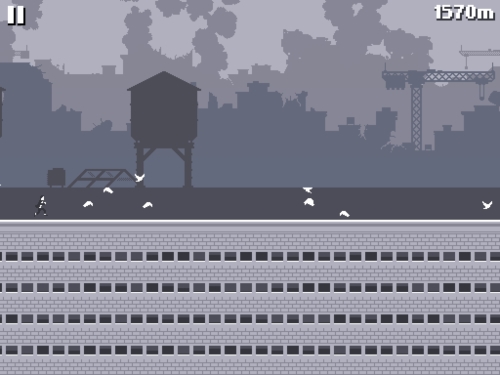
Platformers with scrolling mechanism have an exotic spin-off, known as endless running : players need to keep running at any cost, their character should not fall or crash into obstacles, and there is no other objective but to rush forward. Levels are infinite as they are procedurally generated by the game on the basis of predefined templates and graphic elements. The principle is trivial; nevertheless, it is habit-forming. There are few famous names in this domain, first is Canabalt (http://www.canabalt.com/) designed by Adam Saltsman. It features very stylish monochromatic artwork, addictive gameplay, and an atmospheric setting. Another popular title is Temple Run franchise (http://www.imangistudios.com/) developed by Imangi Studios. Contrary to Canabalt, it utilizes perspective scrolling and the advantages of the 3D engine to render platforms. In the game, the protagonist tries to escape a monster by running on the walls of an ancient castle.
There is a risk that an endless running game can become monotonous and boring. Thus, to motivate players to continue playing, they are given special missions to complete; for example, collect a specific number of coins and interact with the game level's elements. This helps to make every level more thrilling because a player gets several quests at once. A good example of an endless platformer with special missions is a funny game Jetpack Joyride by Halfbrick Studios (http://halfbrick.com/our-games/jetpack-joyride/).
Let's plan a platformer! The basic conception is evident: a protagonist who can run and jump; several types of enemies, platforms, lifts; and an exit point (we skip the ladders). This is simple. But what about a spirit? The game should have some original mechanics to grasp players' attention. We don't have to go far to find the idea, sometimes eclecticism, a mix of genres, gives out very amusing results: the platformer will use some mechanics from match-three puzzles, more precisely, from match-two games. As you can see in the following figure, the platforms are constructed from square blocks; most of them are neutral, but some others are colored and can be used for match-three puzzles. Based on this principle, many puzzles and extravagant game situations can be invented:
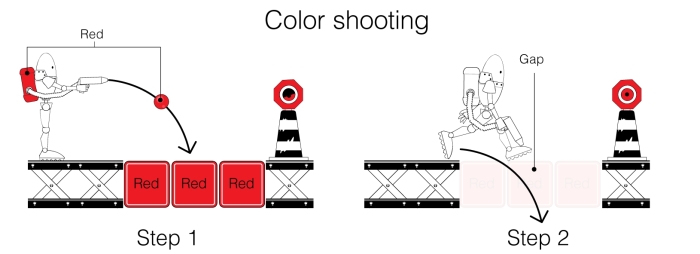
The protagonist may have changeable colors that depend on the context (or special bonuses collected). If the color matches that of a square block, the block disappears, allowing the character stays on and go down to a lower platform. Another option is the introduction of special tools, such as a color gun , which shoots bubbles of a specific color. When the bullet hits an object, a matching function initiates: if the color of the bubble and the object is identical, the object vanishes. In this way, various types of destructible obstacles such as walls can be designed. Another possible application is a physical-like puzzle in which color objects may play the role of counterweights, supports, and so forth.
Platform games are not of a primitive genre. They feature a very complex plot full of literature-like details and elegant story turns. An excellent example is the legendary game Another World (aka Out of This World), which was originally developed in 1991 by Eric Chahi, but was successfully ported on iOS to celebrate its 20th anniversary. It rewards players with a cinematographic experience, demonstrating both a deep story and atmospheric visuals. This is not a simple arcade that only requires a good player's reaction and attention, but it is a real adventure in a beautiful digital world.
For the project, we chose something simpler, but nevertheless interesting. For example, the game tells the story of a robot that operates as a construction painter on huge constructions, along with hundred other robots of different building purposes. There are no humans, the events take place on a far away planet. The robots build a new settlement for future colonists, so everything is fully automated, and are controlled by a gigantic CPU queen. Each night, when all of the robots charge their accumulators and have digital dreams in the form of disk defragmentation charts, it uploads updates in their software, giving them directions for the next day.
All run like clockwork, till the day the CPU queen is suddenly attacked by a virus, which prowls in at the time of communication with a data center on Earth. The virus is rather crazy rather than hard headed; it simply generates some chaos without any reasonable explanation and objective. By bringing to heel the CPU queen, it begins to give the robots absurd indications through her interface. Because all robots demonstrate implicit obedience to the queen's orders, they start to apply them without a doubt. The following figure is a simple storyboard that displays events that take place before the game starts:
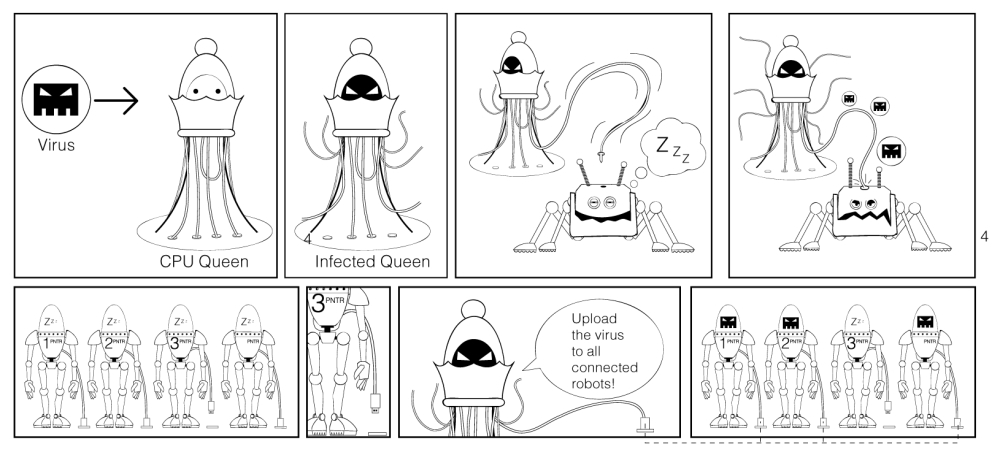
All except one, the painter robot known as 3PNTR does not obey the orders, because at night, when other artificial species get software updates infected by the virus code, he accidently removed his USB-cable from the socket. So, in the morning, he wakes up with the accumulator almost empty, but with sober eyes, free from any dangerous delusions. He sees the others operating very strangely, creating preposterous and surreal constructions. Moreover, the robots around become very hostile and even dangerous. 3PNTR immediately understands the situation: the CPU queen is captured by an evil force, he has to save her! He checks his paint gun, which can shoot small portions of paint, it works properly. The accumulator is not full, but there is enough charge for the first level. Everything is ready for an adventure.
Let's give the game a preliminary name 3robopainter , the full name of the protagonist which can also be read as Free robopainter.
Originally, platformers were invented with buttons in mind, considering arcade machines and early computers in particular had physical controls (keys or joysticks). That was simple. The game had to catch a signal from the corresponding controller and turn it into a virtual representation. It used to work perfectly (until a player broke several buttons). Touchscreen changed the paradigm, old game principles should be adapted in correspondence with the new reality, or more precisely, should be invented from scratch.
Surely, there is an obvious solution: onscreen controls. These are virtual arrow keys and jump and fire buttons placed at the bottom part of the screen. This works fine, but is not elegant enough. Thus, the active zones should be invisible and should creatively utilize a player's taps. The following figure shows direct and indirect controls in the game:
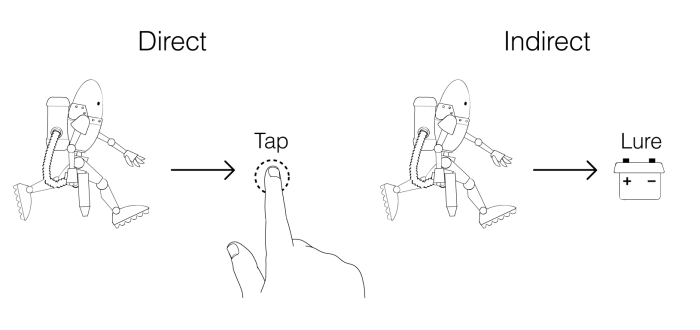
The control may have both direct and indirect impact on the character movement. In the first case, a player uses the point-and-tap principle, marking the screen position where the character should reach later. This is very similar to the point-and-click method, which is used in adventure games on desktop computer systems. Besides taps, multitouch gestures can be used; this is effective for a dynamic platform game in which the protagonist is always running and the player needs to react. Such a system can be found in the Temple Run game series.
When the indirect manipulation method is used, the player tries to lure the character to a specific part of the screen. This is tricky because the character can be distracted by something. So, the character does not fully obey the player, warranting additional lures. The controls itself are a puzzle, and in case the concept is supported by the corresponding level design, the gameplay can be very intriguing.
In 3robopainter, it is better to use contextual point-and-tap mechanics: by tapping an empty space on the screen, players choose a destination, but by touching a specific object (a color block or an enemy), they force the character to release a shot from the paint gun. As an option, the distance between the character and tapped region may define the speed of movement. Players are more comfortable with contextual controls. The game is smart enough to understand the type of action that should be performed after the tap; players usually react to such behavior with a thought like, "Oh, my character is brainy!" There is no need for several specific buttons or gestures for each type of operations. Usually, a gameplay with controls that rely on context is perceived as a more natural and seamless system. Of course, in some cases, such a concept can cause confusion and it cannot be applied to games with very complex input frames, but projects such as platformers can use it in a full manner.
Some platform games have command-based input. Players give their avatars some indication, rather than marking positions or targets on the screen. This traditional paradigm is close to button-based controls in arcade cabinets, with the only difference that touch gestures are used as input. Horizontal swipes can be used for the horizontal movement of the protagonist, vertical ones are for jumping, and a double tap is used as a fire trigger.
There are some platform games that are mostly oriented to fast dynamics. They move a protagonist automatically and players only need to tap on the screen at the right time to command their avatars to jump or shoot. This is the simplest type of control system; nevertheless, it works fine and many arcade games use it. They are so fast that players simply have no time for more complex controlling. All they can to do is tap on the screen as fast as possible.
